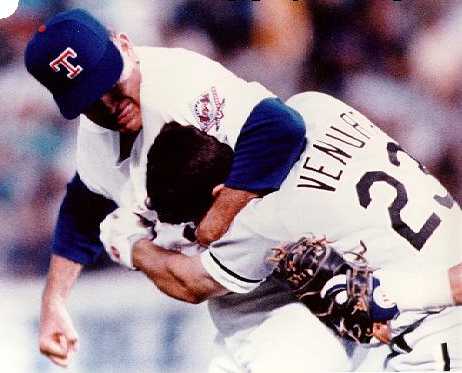
SS Jimmy Rollins
RF Jayson Werth
2B Chase Utley
1B Ryan Howard
CF Shane Victorino
LF Raul Ibanez
3B Pedro Feliz
C Carlos Ruiz
OR
SS Jimmy Rollins
CF Shane Victorino
2B Chase Utley
1B Ryan Howard
RF Jayson Werth
LF Raul Ibanez
3B Pedro Feliz
C Carlos Ruiz
Both of the above lineups avoid the dreaded TRI-LOOGY scenario and both offer their advantages. Both Werth and Victorino had coming out parties in 2008 that proved conclusively that they are great complimentary players to have on a team. Both have very good speed and both are tough outs at the plate. Vic offers blazing speed and an ability to turn a single or a walk into a double with his legs. Vic led the team in batting average and showed good power numbers for a centerfielder. Granted he's not your prototypical # 5 hitter but he could serve as a plate setter for the bottom half of the lineup. Having him bat in front of Ibanez in the 6-hole could very well give Ibanez a ton of RBI opportunities. Putting Jayson Werth in the 5-hole is a more traditional approach. Werth has flashed some impressive power, particularly against left-handed pitching which he absolutely kills. He takes a lot of pitches, knows how to get on base and has gotten better every year he's been a regular. He has below-average power against right-handed pitching but he still gets on base at a very good clip because of his excellent pitch recognition (.360 OBP against rightys in 2008). Having Werth in the 5-hole allows Victorino to stay at the top of the lineup acting as a second leadoff guy behind SS Jimmy Rollins. Either way, its not as bad a situation as it appears to be at first glance.
Another thought to consider when looking at Ibanez's 3 year contract is the imminent arrival of some potentially very good right-handed bats to balance the lineup in 2010 and 2011. Hopefully, both Jason Donald and Lou Marson will be regulars at 3B and C respectively and will provide for a very balanced lineup from 1-8. Donald has gotten a good number of reps at 3B in the Arizona Fall League and he is almost certain to get a good amount of time at that position next year as they prep him to take over for Pedro Feliz at the hot corner. C Lou Marson shot up the prospect lists with another huge step forward in 2008. Marson doesn't show any real power at the plate but he possesses excellent strike-zone recognition and he get's on-base at a very impressive pace. Between the two of them, the Phillies will have less issues from the right side of the plate than most people think.
Other than the apparent lefty-heavy lineup, the greatest argument against the signing is his advanced age of 36 (37 in June 2009) and the length of his contract (signed through Age 39). Ibanez has been a very late bloomer and he has shown remarkable consistency throughout his mid-30's. So far, he hasn't shown any signs of decline. However, when a decline does come, it usually comes fast and we shouldn't be too surprised if Ibanez is ineffective or needs to be platooned for the final year of this deal. However, considering his contract is not too onerous at just over $10 million per year, it won't be worse or even comparable to the dead money invested in guys like Adam Eaton or Geoff Jenkins this upcoming season. It won't hamstring us too greatly from signing players that need to be signed or in locking up guys like Ryan Howard and Cole Hamels in long-term deals.
So, in closing, I will go out on a long, thin limb and boldly predict that Raul Ibanez will have a better 2009 and 2010 than Pat Burrell. I will gladly revisit this comment this time next year but I highly doubt I will be wrong. Personally, I think Raul Ibanez could very well be exactly what our lineup needs and I think all those that criticized this signing will look quite silly for the next couple seasons.



















